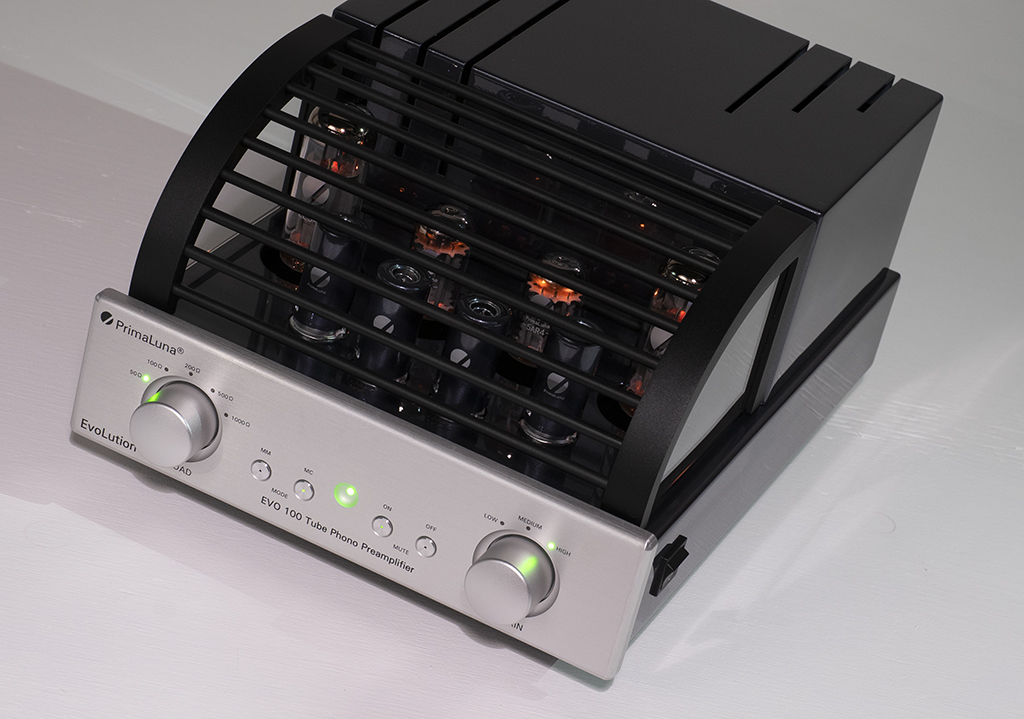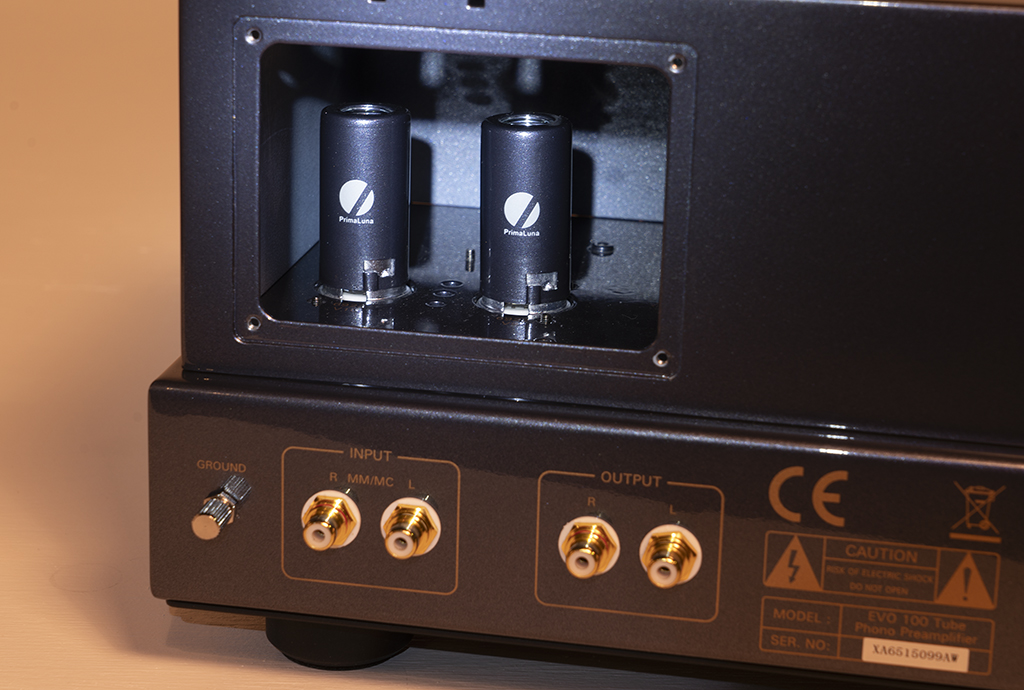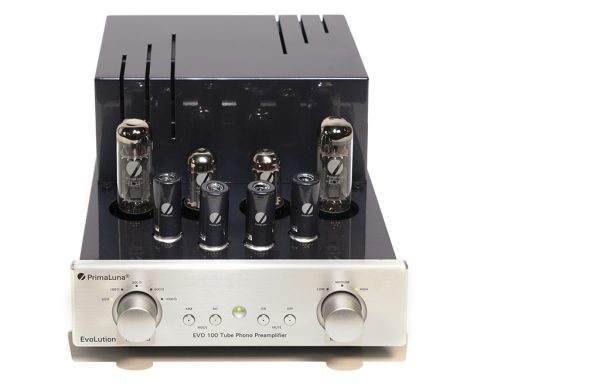The PrimaLuna EVO100 Phono A sublime sense of reality
By Jeff Dorgay and Chris Harr
Listening to PrimaLuna’s new tube phonostage begins with an audiophile cut for a change. If you haven’t had a chance to hear Earth & Wood on Yarlung Records, this is an incredible piece of music exquisitely captured. The tone and dynamics are out of this world good. Seeing the EVO 100 Phono has a 50-ohm setting for MC loading, Rega’s Apheta 2 mounted to a Rega P9 is the toughest cartridge to drive on hand. The Apheta cartridges often get a bad rap at being thin and strident sounding, but nearly all the time they are loaded at too high of an impedance setting. 25-50 ohms is the key to unlocking the speed and transparency that this cartridge offers, and the EVO is a perfect match.
Next up, the SME 20 with a Lyra Helikon reworked by Ana Mighty Sound delivers a completely different voice. Not quite as contrasty from top to bottom, the Lyra has considerably more inner detail and front to back depth. Tracking through a handful of Blue Note remasters delivers a luxurious, texture filled presentation, that brings these classics to life.
Going off on a different tangent, the Technics 1200GR with Luxman LMC-5 is the last choice, again, we’re talking about different and subtlety, rather than hit you over the head differences, but you should know that the EVO 100 possesses more than enough resolution to let all of these different cartridges shine.
A long time in the making
PrimaLuna fans have been asking Herman van den Dungen at PrimaLuna when they would make a killer phono stage offering a level of performance and value to match their award winning amplification products for some time now. They’ve produced a CD player and recently a DAC – both upholding the PrimaLuna traditions of value, performance, and execution. (Staffer Sean Zloch owns the DAC and loves it, btw.) You have to hand it to Mr. van den Dungen for keeping a poker face, he’s never even hinted that they were actually doing this project.
Well, it’s here and it’s fantastic. Though it’s commonplace today to spout superlatives at every turn in the audio reviewing world, the EVO 100 Phono gets highest praise, as I own a handful of great $10k-ish phonostages from ARC, Backert Labs, BAT, Pass Labs, and VAC. The 20k-ish Nagra Classic Phono is also here for listening, so when I say that the EVO is one of the best deals going in a $3,700 phono and delivers performance you’d expect to pay more for, it’s not empty praise. It’s been compared to several great phono stages, with a wide variety of cartridges.
PrimaLuna has been around for 20 years now, and their components stand the test of time. Check your favorite internet forum, EBay, or Audiogon. There’s rarely many used PrimaLuna components for sale. People tend to keep em. For those of you that haven’t heard me say this often, I still have my ProLogue One integrated that I reviewed for The Absolute Sound 20 years ago. Just over 2,500 components have come through the door as TONE approaches its 19th birthday, and this one’s still delivering the goods. So, this is a product you can buy with total confidence.
Break it down again
The EVO 100 Phono uses a half-sized chassis, like the original PrimaLuna integrated amplifiers, the current EVO DAC and the EVO 100 series products. The physical design and styling match all PrimaLuna products, with the familiar dark blue metallic chassis, black or silver matte front panel, and the Coney Island Hot Dog warmer tube cage. It also comes triple boxed to make sure it is not damaged in transit, and a pair of gloves so you don’t smudge it when installing. If this is your first go around with PrimaLuna, you’ll be impressed with how well their products are packaged.
Though the EVO 100 Phono offers MM and MC capability, there is only one phono input on the rear panel. This is the only real complaint I have with it, and it’s unfortunate that they couldn’t have at least gone the route of having a separate MM and MC input, allowing you to use two turntables, or even using an external step-up transformer with the MM input. A single pair of RCA outputs are also supplied for output to your preamplifier or integrated of choice. With a pair of 6922 tubes for the MC stage, the main gain and MM stage each use a pair of 12AX7 tubes. And all the gain tubes have those vintage coolio metal cans to keep noise down.
Space the final frontier
Even though people are still arguing about analog versus digital, the spaciousness that analog brings to the listening experience is always exciting. Side one of Earth & Wood features Lou Harrison’s 1940s “Canticle No. 3.” Performed by the Smoke and Mirrors percussion ensemble, this track features a steel guitar and a number of vintage percussion instruments. The closest comparison would be to some of the Mickey Hart Drumming at the Edge work. The spaciousness of this recording through the recently installed Peak Consult Sinfonia speakers is massive.
Moving back to more familiar territory, Paul Weller’s first solo album proves equally engaging. Though this record feels digitally mastered, that feeling of a nearly endless soundstage is incredibly cool, revealing fine details not as easily discernable in the Japanese CD version. Isn’t that what vinyl is all about? Uh huh, oh yeah.
The vinyl version of Kruder & Dorfmeister’s The K&D Sessions is perfectly suited to this turtable/cartridge setup, and the tonal saturation that the PrimaLuna adds to the Rega makes for a Technicolor/Superscope presentation. The bass hits hard, and the tinkly bits float around the room. This all-tube design is a master of rendering three dimensional space, precisely the thing I gravitate towards tubes for.
MM and MC
While Chris did not achieve incredible synergy with the EVO 100 and the MM cartridges he had on hand, the Technics 1200G and Concorde Silver (basically a higher performance Ortofon OM40 in a Concorde body) used here was perfection, as well as our other MM reference, the Clearaudio Virtuoso Wood. Both delivered the dynamics you associate with taking the MM path. My least favorite matchup with the EVO 100 on the MM side, was the Linn LP-12 Basik, sporting their Adikt II cartridge. Sometimes it’s just how the planets line up, but this combination is already somewhat on the romantic side, so this might just be a bit too much of a good thing. And remember, I’m the guy on the staff that leans to the warmer side of things.
An interesting aspect of the EVO 100 Phono is the all-tube design – no step up transformers, Op amps, or solid-state gain stage anywhere. A pair of hand-picked 6922s are hidden around back, in a sub enclosure (behind a little door) with the circuit board suspended from the main chassis. You simply remove a small pair of posts to remove the door for tube access. This only delivers 60dB of maximum MC gain, but also adds a level of circuit purity and tonal saturation that others do not. The medium and low gain settings are 56dB and 52dB, handy if you have a high(er) output MC that ranges from .9mV to 2.5mV.

It’s slightly on the low side for something in the .25 – .30mV range, like a Denon 103 if you have a preamplifier/linestage with low to moderate gain. However, when feeding the Pass XS Pre and the conrad-johnson ART88 (in for review) we had no problems with lower output cartridges. And it’s a perfect match for an all PrimaLuna system. If you have a MC cartridge in the .4mV – .6mV range, you will be fine regardless. The EVO offers loading at 50, 100, 200, 500, and 1000 ohms for MC and two capacitance settings of 47pF, and 100pF for MM.
Many different system configurations were tried, however most listening was done with the Pass gear and Peak Consult speakers. While the EVO 100 lacks the ultimate level of resolution of the $10-$20k phonostages on hand here, (as it should) to coin an old audiophile cliché, they are only sins of omission. Yet dynamically, the EVO leaves precious little on the table compared to some of the industry’s finest thanks to the enormous power supply with tube rectification handled by a pair of 5AR4s and regulation from a pair of EL34s. It’s like getting out of a Carrera GTS and getting into a standard model 911. After about half an hour, you don’t really miss that extra 50 horsepower all that much.
I have to confess to not being much of a tube roller, but considering the luck I have had with PrimaLuna pre and power amplifiers, I’m guessing those of you that want to invest in some premium NOS tubes for this phonostage can probably wring even more performance from it. This is not to say it is necessary to enjoy the EVO 100, but the most fanatic among you can probably take it a click or two further, should you choose to experiment.
There was a time that almost four grand was crazy money for a phonostage. Today not so much, but for many analog enthusiasts this is still a major commitment of resources. To that effect, the EVO Phono is more than worthy of an Exceptional Value Award for 2023. I know I could live with one of these forever – and with shopping season around the corner, i still may purchase one. Highly recommended.
To get a better handle on how it stacks up to something much more in the same price neighborhood, I sent it over to Chris’ house for a while as he has been listening to the Modwright 9.0 SE (now with X mods) for some time. Here’s his take on the two.
Additional listening; Chris Harr
For several months, I’ve been thoroughly enjoying ModWright’s PH 9.0 phono stage ($3,500). So much so, I recently returned the unit to ModWright for the “X” upgrades (+$1.250). While the “X” mods are entirely positive, they don’t transform the PH 9.0 into an entirely different phono stage. For that reason, it seemed obvious to compare it to the $3,695 PrimaLuna Evo 100 Tube Phonostage.
For initial listening, the PrimaLuna Evo 100 Phonostage is paired with an Avid Volvere SP with a Kuzma 4 Point 9 tonearm. The phono cartridge selected is an Ortofon Cadenza Bronze modified by Andy Kim at the Needle Clinic with a boron cantilever and micro ridge stylus. Listening to the Evo 100 phono stage, I’m quickly struck by a smooth, liquid and well-layered midrange while listening to Clementine on Halsey’s (Ashley Nicollet Fragipane) Manic album. Make no mistake, Halsey is a pop singer/songwriter of a special quality. Her voice carries a textured emotional depth and the PrimaLuna allows that nuance to be clearly heard. Contrasting overdubbed vocals emerge from a space behind the main vocal rather than blending with the primary vocal. The effect is haunting, in a good way, as though we’re hearing a bit of raw emotional desperation.
Later, listening to “Little Death” from The Beths’ debut album Future Me Hates Me, I’m greeted with the expected crystalline triangle-type sound at the beginning of the track followed by a rapid, light cymbal tap before the song transitions into wall of electric guitars over the top of galloping drums. The Evo 100 keeps the dense instrumentation well-separated and clearly placed in the soundstage.
Next, a ProJect X8 with a Nagaoka MP-200 cartridge (4mV MM) and Cardas Cygnus phono cable is plugged in to assess the PrimaLuna’s MM input. I found the overall combination to be excessively weighted toward the bottom octaves and relatively dark sounding overall. This same configuration is warm through the ModWright also, but very satisfying especially with recordings which tend toward being “hot” in the upper midrange and treble.
Finally, a Rega RP6 with a Dynavector 20x2H (2.8mV HOMC)is substituted. The sound is clear and well balanced, if not as intense as I was accustomed to through the PH 9.0. Overall, I am left with the impression that the Evo 100’s MM stage is best paired with livelier, brighter sounding MM cartridges. I’m sure some of this could be changed by a little tube rolling in the MM section.
My evening concluded by switching back to the Avid and listening to Phantogram’s Eyelid Movies. Phantogram recordings fall into a special category of electronic rock/dream pop with sequenced beats. They’re intense, fun albums but are far from being “audiophile” quality recordings. Despite the average recording quality, I was again struck by the smooth, textured clarity of vocals through the Evo 100.
While the majority of Phantogram’s songs are sung by Sarah Barthel, the occasional track is sung by guitarist and producer Josh Carter. His voice often falls back into the mix, lacking nuance. Through the PrimaLuna, he emerges in a convincing, textured manner not experienced before. Very impressive.
A major difference between the ModWright to the PrimaLuna is how differently they present dynamics. The Evo 100 builds from the bottom-up, whereas the ModWright builds top-down from a higher average intensity level. High frequency dynamic details emerge from the Primaluna, as though someone were turning up a dimmer switch in a darkened room. From the ModWright, the ambient light level is higher, and the color temperature changes instead.
The ModWright PH 9.0X presents dense rock and pop recordings in a stable, lively manner with tighter, punchier bass and equally extended low frequencies. Paired with the Focal Scala Utopia Evo’s powered by a Parasound JC5, The lower octaves and overall tonal balance are more satisfying through the ModWright with rock, pop and electronic recordings, the types of music I listen to most often.
To my ear, The PrimaLuna Evo 100 Phonostage is the warmer, more organic sounding phono stage, excelling at presenting a comparatively more layered midband, remaining unflustered when complex passes occur and remaining sweet in the top octaves.
An audition of the PrimaLuna would be easy to recommend, especially to vinyl enthusiasts who gravitate toward acoustic and vocal based recordings.
$3,695




